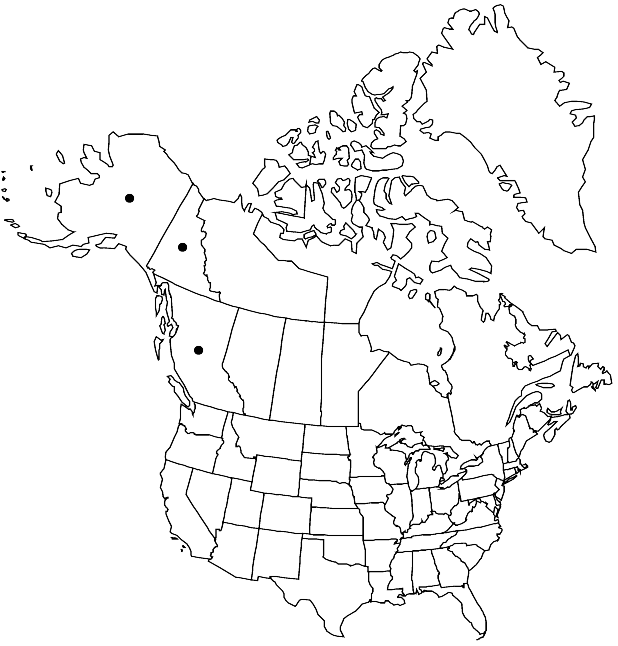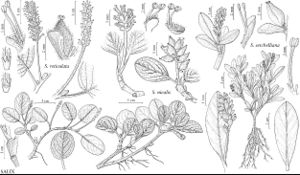Difference between revisions of "Salix setchelliana"
Univ. Calif. Publ. Bot. 17: 410, plate 72. 1934.
FNA>Volume Importer |
FNA>Volume Importer |
||
| Line 51: | Line 51: | ||
|publication year=1934 | |publication year=1934 | ||
|special status= | |special status= | ||
| − | |source xml=https://jpend@bitbucket.org/aafc-mbb/fna-data-curation.git/src/ | + | |source xml=https://jpend@bitbucket.org/aafc-mbb/fna-data-curation.git/src/f6b125a955440c0872999024f038d74684f65921/coarse_grained_fna_xml/V7/V7_60.xml |
|genus=Salix | |genus=Salix | ||
|subgenus=Salix subg. Chamaetia | |subgenus=Salix subg. Chamaetia | ||
Revision as of 20:23, 24 September 2019
Stems erect or semi-prostrate; branches gray-brown or red-brown, glabrous or woolly to glabrescent; branchlets reddish, densely woolly (hairs spreading). Leaves: stipules absent or rudimentary; petiole (shallowly grooved adaxially), 0–3 mm; largest medial blade narrowly oblong, narrowly elliptic, elliptic, oblanceolate, or obovate, 25–87 × 10–30 mm, 2–3.9 times as long as wide, base cuneate or convex, margins flat, entire or serrulate, apex rounded to convex, abaxial surface glabrous, adaxial dull, glabrous; proximal blade margins entire or serrulate; juvenile blade glabrous. Catkins (sometimes branched); staminate 12–27 × 6–10 mm, flowering branchlet 3–8 mm; pistillate densely flowered, stout or subglobose, 20–34 × 6–13 mm, flowering branchlet 5–19 mm; floral bract tawny or greenish, translucent, 2–3.6 mm, apex rounded or truncate, erose, sinuate, irregularly toothed, or entire, abaxially glabrous. Staminate flowers: abaxial nectary 0.4–0.8 mm, adaxial nectary narrowly oblong, oblong, or ovate, 0.6–1 mm, nectaries distinct, or connate and shallowly cup-shaped; filaments distinct, glabrous or hairy basally or on proximal 1/2; anthers long-cylindrical, 0.6–0.8 mm. Pistillate flowers: adaxial nectary oblong, 0.8–1.3 mm, equal to or longer than stipe; stipe 0–0.6 mm; ovary obclavate or ovoid, beak abruptly tapering to styles; ovules 16–23 per ovary; styles distinct, 0.3–0.4 mm; stigmas flat, abaxially non-papillate with pointed tip, or slenderly cylindrical, 0.32–0.47–0.6 mm. Capsules 3.6–10 mm. 2n = 38.
Phenology: Flowering late May-late Jun.
Habitat: Pioneer on sandy to gravelly beaches, bars along glacial streams, glacial moraine
Elevation: 10-1100 m
Distribution

B.C., Yukon, Alaska.
Discussion
Salix setchelliana shares some unique characters with members of subg. Longifoliae and some Populus. It produces shoots from roots, the catkins are sometimes branched, and the leaves are isolateral, with hypodermis present on both sides of the blade (W. Buechler, pers. comm.). While it is possible that these characters evolved independently, it is more likely that they were derived from a common ancestor.
Salix setchelliana is a highly successful colonizer of temporary gravel bar habitats. This is made possible by rapid expansion of its clones by root shoots and its ability to become established in new locations by both seedlings and clonal fragments (D. A. Douglas 1989).
Hybrids:
Salix setchelliana forms natural hybrids with S. niphoclada.
Selected References
None.
